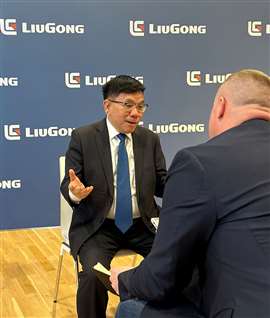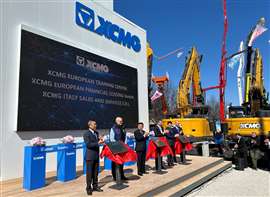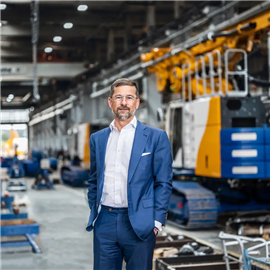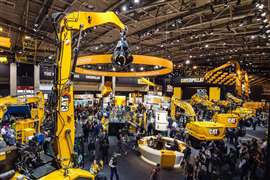The trade war is forcing construction equipment OEMs to think again about exports
23 April 2025
 LiuGong Chairman Zeng Guang’an during the company’s bauma 2025 press conference. (Image: Mitchell Keller)
LiuGong Chairman Zeng Guang’an during the company’s bauma 2025 press conference. (Image: Mitchell Keller)
The sun was shining on Munich, Germany, to open day one of the world’s largest exposition fair on 7 April.
But somewhere behind the brightly coloured spectacle of product launches and innovation showcases, lurked the spectre of US President Donald Trump’s import tariff plan.
“Every four years they have a new president”
Trump has suspended planned high tariffs on most countries around the world for 90 days (outside of a 10% baseline). But he did not spare China; instead the two nations have engaged in a tit-for-tat round of tariff increases. They now stand 145% on Chinese imports to the US and 125% on US imports to China.
That poses something of a headache for Chinese manufacturers and indeed companies elsewhere who manufacture products in China.
China has exported more construction machines than it has sold domestically for the the past two years, according to Off-Highway Research.
The specialist market research consultancy puts the number of construction machines Chinese firms exported last year at 235,000, making it the biggest exporter in the world ahead of Japan. That includes all exports, regardless of brand. For example, Caterpillar is a major exporter of road building and earth moving equipment out of China, while Fayat Group also exports road building equipment, and Bobcat exports skid-steers, and the list goes on. Some of those exports are to the US.
All OEMs, regardless of where they are based, found themselves being asked about how they were reacting to tariffs while at Bauma.
It was perhaps fitting that a banner behind LiuGong’s chairman Zeng Guang’an’s head read “Tough World” as he addressed the tariff issue in response to a question from Construction Briefing at Bauma.
Asked whether North America remained a strategic focus, Zeng did not hesitate. “Today they have too many tariffs on Chinese equipment,” Zeng said. “We believe we will survive because I believe the world will change. Every four years they have a new president.”
 LiuGong Chairman Zeng Guang’an in a press interview at bauma. (Image: Mitchell Keller)
LiuGong Chairman Zeng Guang’an in a press interview at bauma. (Image: Mitchell Keller)
Ultimately, Zeng said, LiuGong is not exiting the US market, but it is stepping back, waiting to see whether a change in leadership might reverse the tide of protectionism.
Zeng noted that LiuGong holds a global presence, including a North American headquarters and manufacturing facility in Texas as well as dealerships across the US, Canada and Mexico. That’s all to say that US import tariffs may not have an outsized impact on the company.
He added, in the short term, North American emphasis will be on two other countries, instead. “But for LiuGong, we look at North America as three: Canada, US and Mexico. We are focused on Mexico and Canada, but we will keep a presence in US.”
Instead of focusing on the US, LiuGong used its presence at Bauma to announce its ambitions for the European market. As OEMs recalibrate, many are doubling down on European operations. Howard Dale, chairman of LiuGong Europe, said the company is investing in local expertise, regional hubs, and customer-specific solutions.
“We’re launching five new machines at Bauma, expanding our battery electric line-up, and deepening relationships with dealers and key accounts,” Dale told Construction Briefing. “The innovations we’re showing today have been developed alongside European customers in real-world applications.”
Dale also highlighted investments in Italy, France, and Germany, calling these hubs “strategy centres” for faster service, stronger partnerships, and European-specific product development.
XCMG’s silence on US market
 XCMG officials inaugurate three new European initiatives during the company’s bauma 2025 press conference. (Image: Mitchell Keller)
XCMG officials inaugurate three new European initiatives during the company’s bauma 2025 press conference. (Image: Mitchell Keller)
XCMG, meanwhile, avoided the topic of the North American market altogether.
Despite promoting its presence in over 190 countries and showcasing new electric machines and digital platforms, the company made no mention of North America during its press event at Bauma.
This is a contrast with previous years when Chinese OEMs openly courted US distribution.
Instead, XCMG executives highlighted European expansions, including a new training centre, financial leasing arm, and localised R&D presence.
The company celebrated delivery orders with European dealers and promoted vertically integrated electrification, yet left the US market completely unaddressed; perhaps serving as an example of what’s left unsaid is as important as what was said.
A renewed focus on other export markets?
It was a similar story when Construction Briefing spoke to the head of another Chinese construction equipment manufacturer, who did not want to go on the record.
The company still professes publicy to be targeting both North America and Europe for exports. But the company’s managing director did not mention the US at all and was instead keen to find out as much information as possible about how to raise awareness of the brand in Europe ahead of expansion in the region.
Another sales manager for a Chinese OEM with responsibility for the Middle Eastern markets told colleagues from Construction Briefing’s publisher KHL Group that their sales targets for the region had been doubled in the wake of Trump’s tariffs announcement. Meanwhile, machines produced by the company that had already been en route to the US had been diverted to other locations around the world to avoid tariffs.
While US tariffs are undoubtedly a challenge for Chinese firms, China’s brand presence is not as big in North America as it may appear. Off-Highway Research put the market share of big Chinese OEMs in North America in 2024 at just 2.3% (that compared to 5.1% in Europe).
Chinese OEMs may have been keen to succeed in North America, but they also have comparatively little to lose.
“It’s all very well to say they’ll divert product to Europe, but they’re already doing better here than in the US,” says Off-Highway Research’s Chris Sleight. “I would say the limitation in Europe (and prior to the tariffs in the US, too) is about the strength and reach of their distribution networks more than anything else. As newcomers to the market, they had to piece together distribution from small dealers which did not have earthmoving equipment in their portfolios. These fragmented networks of small dealers can’t compete with the major distributors like Zeppelin, SMT, Kiesel, Ascendum, etc.”
In fact, it’s emerging markets where Chinese OEMs are having greater success, says Sleight. The total sales of Chinese-branded construction equipment in Europe and North America was about 17,000 units, which is only about 7% of total Chinese exports, he adds.
“In emerging markets, Chinese OEMs’ low purchase prices are a big advantage (as opposed to the total cost of ownership thinking in Europe and North America),” Sleight says.
‘Safeguard’ tariffs
In any case, regulators in Europe are unlikely to sit back and watch Chinese machines flood through the borders. In fact, both the UK and the European Union were already sensitive to the issue. They took measures towards the end of 2024 to address “dumping” of cheaper Chinese machines in their markets.
As of 21 December 2024, the UK government applied provisional anti-dumping rates of duty ranging of up to 64.17%% on some imported Chinese excavators, in response to an application from UK manufacturer JCB. That was after the TRA found that Chinese exporters undercut UK prices by an average rate of 23.4% thanks to reduced production costs.
Any machines weighing below 11t and above 80t did not attract an anti-dumping rate. But in early 2025 the TRA made further calculations and recommended varying rates according to manufacturer on machines at 11t and above but below 80t. Those included a 35.32% rate on machines manufactured by LiuGong, 44.33% on companies owned by XCMG and Sunward, and 56.77% on Sany Heavy Machinery. All other overseas exporters in the weight range have to pay 64.17% duty.
A spokesperson for the TRA told Construction Briefing, “While the TRA doesn’t comment on specific international trade policies such as US tariffs, our investigations do consider market conditions and trade patterns as part of our analysis. We encourage industries to approach us to discuss any concerns they have about unfair international trade practices.”
In January 2025, the European Commission imposed “definitive” anti-dumping measures on imports of mobile access equipment from China. The European Commission said dumping was “causing significant harm” to producers of mobile access equipment. Imported machines from Dingli attracted a 20.6% tariff, while the rate for other “cooperating companies”, who were understood to include LGMG, Zoomlion, XCMG, Sunward, Haulotte, Liugong and Mantall, was set at 30.1%. All other companies attract a rate of 54.9%.
In the wake of tariffs, the European Commission has announced plans to protect itself from “trade diversion”. President Ursula von der Leyen discussed China’s critical role in addressing trade diversion with China’s Premier Li Qiang earlier this month. The European Commission has also set up an ‘Import Surveillance Task Force’ to track trade diversion. “We will work with industry to make sure we have the necessary evidence base of our policy measures. We will stay in very close contact to minimuse effects of our actions on each other,” a spokesperson for the European Commission said.
European firms mirror cautious US outlook
 Peter Hingott, Bauer CEO (Image: Bauer)
Peter Hingott, Bauer CEO (Image: Bauer)
Of course, even in light of Trump’s 90-day suspension of tariffs on other countries around the world, OEMs outside of China are monitoring the situation with some trepidation.
Peter Hingott, CEO of Germany-based Bauer Group, echoed the uncertainty, noting that new tariffs have already begun to delay major purchasing decisions in the US market.
“I’m not as optimistic as some of our American customers,” Hingott told Construction Briefing. “They think this tariff stuff will be sorted out in weeks. I don’t think so.
“If it stays longer, it will hit us definitely in 2025.”
He described the US as an important market with strong recent performance; but one where new orders are likely to slow significantly due to increased duties on high-value machines.
“We’re talking about machines that cost €2-5 million,” Hingott said. “A 20% tariff is a lot.”
The turmoil created by Trump’s tariff announcements should serve as a wake-up call for European manufacturers to look for new export markets, according to the Committee for European Construction Equipment (CECE).
Executives from CECE, which represents 1,200 European construction equipment manufacturers through national trade associations, made the comments at the launch of CECE’s latest economic report during the Bauma.
CECE’s economic affairs manager Sebastian Popp said the situation was “quite alarming”. “It clearly tells us that the stakes are high. I am not saying that if the tariffs are put in place, all these exports will go away. That will not be the case. But it is pretty clear for us as an industry that we need to be able to compensate in other markets.”
 JCB celebrates the construction start for its new facility in Texas, US. (Image: JCB)
JCB celebrates the construction start for its new facility in Texas, US. (Image: JCB)
CECE secretary general Riccardo Viaggi added, “The export market is not going to disappear because of tariffs. It may be reduced, and it will be more costly for clients to buy. At some point, we need to find alternative routes.” The Americas and India are two regions that European OEMs could explore further, he suggested.
On the flip side, UK-based construction machinery maker JCB announced it would actually double the size of its planned factory in San Antonio, Texas, US. However, with the site already under construction prior to the April tariff announcements, this move was seen as a buffer against tariffs on UK imports by expanding US-based production.
The US-based Association of Equipment Manufacturers (AEM) also weighed in, warning that the escalating tariff regime is taking a toll. “These tariffs drive up costs for US equipment manufacturers, disrupt our supply chains, and expose our customers to retaliatory tariffs,” said Kip Eideberg, AEM’s senior vice president.
German economic minister warns of irreversible shifts
And it was not just company leadership making note of the unusual times for global trade.
Germany’s Federal Minister for Housing, Urban Development and Construction, Klara Geywitz, addressed the issue during the show’s official opening – at 9:30am, 7 April, prior to Trump announcing a 90-day suspension of many of the tariffs he had proposed.
Geywitz pointed to the machinery and innovation on display as proof of how international cooperation – and free trade – has benefited the global construction sector.
“Free trade has propelled many parts of the world – Germany and also many Asian countries – to a new level of prosperity,” she said. “It isn’t a zero-sum game: it benefits everyone.”
Geywitz spoke shortly after Off-Highway Research released its estimates that new (as of early April) US tariffs could add US$4.2 billion in costs to imported construction machinery in 2024 under Trump’s ‘Liberation Day’ tariffs.
All in all, in Munich, the message was clear: manufacturers are still global, still growing, and still innovating.
But when it comes to America, they’re watching – and waiting.
STAY CONNECTED



Receive the information you need when you need it through our world-leading magazines, newsletters and daily briefings.
CONNECT WITH THE TEAM







